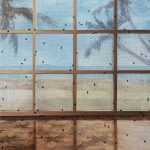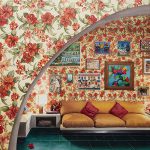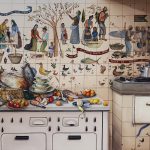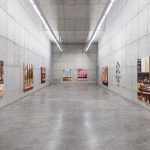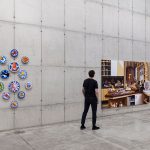ANA ELISA EGREJA | FAZER REALIDADE
by Moacir dos Anjos
In this recent set of paintings, Ana Elisa Egreja continues the artistic program that has been running for a decade and a half, although she continually changes something or expands its edges, making it denser and wider. With each move made, it faces challenges that were previously absent or that, in the past, lacked the urgency of confrontation. In her work, things remain and change; are there and are absent. In it, there is no detour from the paradoxes eventually encountered, but the deliberate cultivation of them.
Country Kitchen (180 x 270 cm): On the main kitchen counter, a variety of grains, fruits and other foods, perhaps about to be combined, cooked and eaten. There is, however, also a bird there. Alive. Strangely, it doesn’t seem to clash with the scene composition. Shelves hold shapes, bowls and various utensils. Inside the cabinet under the counter – Inside the cabinet under the counter – opened by someone no one knows – painted dishes can be glimpsed.
Both before and in the new series, the paintings immediately draw attention for their verisimilitude with what each person who contemplates them knows about the world. They request and receive, from the other’s gaze, the consideration of shapes, colors and textures found in domestic environments, manifesting an interest in architecture and in the ways how, in these rooms, everything in daily life arranges itself. Intern spaces and ordinary things reproduced in “realistically” painted plans, to use perhaps an inadequate adjectivation, since the reality is never fully captured in visual or written processes of representation. These are works that persist replicating what exists as painting, being, at the same time, openly and irrevocably failed as their sensible equivalents. To those who hold their gaze before them, it offers, therefore, not only the sensation of proximity to what it’s presented, but also the strong impression of being in front of something distant from what is already known. An experience produced, however, in different ways on older works and new ones.
Flowered Room (180 x 270): From a room that is not exactly known what it is, another can be seen: part of a living room with no one, in which the entrance is shaped like an arch. Furniture and objects seem to belong to a time far distant from the many paintings seen in the background. The walls of both rooms are entirely covered with repeated images of red flowers; they bring to the house the memory of what only exists outside.
If in the Jacarezinho series – a set of paintings exhibited in 2017 at Galeria Leme – Ana Elisa Egreja used to paint scenarios that were built inside a single house, now she portrays scenes observed in several residences, some of them combined in one image only. And if before unexpected natural elements were inserted in rooms usually inhabited by people – chickens on stairs, octopuses occupying toilets, a small pond where there was a living room floor –, on the new paintings such strangeness almost no longer exists. Even the fruits, which in the previous house seemed to wish to take over an entire kitchen, they seem to assume, in the new painted spaces, a more prosaic and discreet presence. What unites the two series, preserving their differences, is the atmosphere invented by the artist with paints placed on canvas: one that embraces what is already known, but which also irretrievably confuses the gaze. Atmosphere of familiarity and simultaneous strangeness on scenes that are close to the ambiences created in text for a long time by Latin American writers adepts of a so-called fantastic realism – Bioy Casares, Gabriel García Márquez, Juan Rulfo, Julio Cortázar and others. Even in recent paintings, where the supposedly absurd is shelter in a more sparse and silent way, there is always something that disturbs the previous knowledge held about the world represented there.
Pennacchi Kitchen (150 x 200 cm): On the wall above the counter, tiles painted by the artist in the kitchen of her home. Paintings that narrate almost idyllic scenes of harvesting, fishing and sharing of food. On the same counter, well-arranged fruits and dead animals scattered around, including small birds that are usually not eaten by people. Only one of them appears to be alive, a possible witness to a nature that crumbles and dies.
The use of the term realist to qualify these paintings requires yet another consideration: if the common denomination imposes itself on the gaze, it is possible to argue that it is less due to the obvious recognition of things that were painted – there are better ways to promote this verisimilitude after all – and more by the ways in which the paintings are constructed. The more closely one examines the canvases, the less distinguishable (and attractive) the referents represented there become and the more apparent (and attractive) the almost tactile marks of brushstrokes that constitute them as images become. Fine brush marks that carefully distribute, in various ways, oil paint on porous canvases. Brushes that evenly lay and spread the paint used there, that ruffle it up and out of the frame, that bend it to one side or the other, that bring different colors closer together and apart, that superimpose them in agreement or conflict, that create opacities and transparencies in defiance of what can and cannot be deciphered by the eye. Brush marks that could be cataloged as a lexicon of painting with which the artist invents and describes worlds based on the ways she observes the place she inhabits. Each painting has a body made up of several parts articulated with their own syntax.
Cinderella (160 x 130 cm): From the living room of an apartment with parquet flooring, it is possible to see, beyond the wooden and glass frames that go from floor to ceiling, the landscape of a beach – sand, sea, coconut trees. The glass that separates the two spaces painted there is sandblasted, reducing the sharpness of what goes on outside. But the only living being that inhabits the room belongs to the outside, in an invasion/subversion of the place: insects made of lumps of dark paint fixed on the wooden floor and on the window glass.
There is also an ethics embedded in the works. Ethics which consists, first, of a compliment to the obsessive and incessant practice of registering and collecting scenes and environments – noting both the broad characteristics that define them and the more hidden details that compose them. Collection of images (photographed or somehow recorded in memory) which are then recombined for the invention of paintings; to reinvent, through a kind of painted collage, what was thought to be already known. Ethics made, moreover, from a compliment to the deceleration of time. The time making these paintings lasts for what is needed, and not what is established from another place. A time that refuses to be calculated by productivist metrics, valuing resistance and desire. A countless time that is incorporated into extensive paint-covered surfaces.
Frank Lloyd Maragogipinho (150 x 200 cm): There is an overlap of layouts and arrangements, all painted in the typical earthy tones of the things represented there. Brick walls of the modernist house, handmade clay vases above the fireplace, improbable dishes made of the same material flanking them. A kind of profane altar that celebrates, in its invented existence, the power of painting to dissolve distances between any environment and things.
In all the scenes painted by Ana Elisa Egreja, there is always the evocation of a variety of events that could be related to them. None of them heroic or portentous, but linked to unimportant facts of life that repeat themselves day by day. Almost all of them are representations of kitchens or living rooms, always made with enough distance to capture many of the elements that make them unique. And always made from a position of almost respectful frontality. Furthermore, they are paintings large enough so that the bodily relationship established by the artist with the places she paints can be replicated by the bodies of those who find them ready and measure themselves with them. Not as a simulation of places one could enter, but as illusory openings to a world at the same time similar and at odds with what exists, through which it is wagered that it will be possible to see what is happening there. Expression of a desire to see beyond, also evident in the images of windows that appear prominently in various works; windows that lead the gaze out of the closed environments where the painted scenes are made.
Mexican still life in fields (175 x 200 cm): Inside the room, a table covered with a tablecloth decorated with fruits, vegetables and some flowers – plus wooden birds perched on the food. A scene illuminated by the light from the outside, from the lush garden populated by animals, beyond the large glass window. Almost translucent birds and monkeys mix their bodies with the sky and leaves. Painting dismantles the pretension of replicating worlds, asserting itself as their builder.
If the size of the paintings is measured by the artist’s body and that of whoever looks at them, it is noteworthy that there are no people present in the pantings, but only signs of their existence. Furniture, objects, food; there is a lot of almost everything, except those who use all these things. As if the people who inhabit those living spaces had just left there. As if the works suggested common events on suspension – a conversation, the preparation of a meal –, which could only be resumed when the making of the paintings stopped. As if Ana Elisa Egreja sought to answer, with ink embedded in the canvas, questions once posed by poet Carlos Drummond de Andrade: “What is the place like / when no one passes by? / Are there things / without being seen?”. As if it were possible to paint these empty spaces of people without being present and involved in them. Her work, as said, does not take detours from paradoxes; rather, it cultivates them.
Flow Blue (various dimensions): Grouped on the wall in sets, dozens of rounded paintings simulating crockery dishes refer to others seen in other works, as if they were part of them. Dishes that contain fruits, vegetables, vegetables, eggs, fishes and crustaceans created through an extensive and inventory of gestures made of brushes that move and animate paint. Somehow to remind that to paint is to make reality, even when it seems to replicate what already exists.

